How to Prepare Your WordPress Site for a High Traffic Event
We all want tons of traffic to our websites. But what happens when that dream comes true and your website suddenly gets a flood of visitors?
Before you know it, it slows to a crawl or even crashes. That’s not good for business!
So, if you are planning a big marketing event or launching a product you expect to be a hit, then you need to be prepared for that surge of traffic.
How do we prepare for high-traffic events at WPBeginner? We started by building our site on reliable infrastructure that can handle the load. Then, we added a CDN and firewall and optimized everything to be super efficient.
In this guide, we’ll walk you through the types of events that can send a ton of traffic your way. More importantly, we will share our tips for how to prepare your website for traffic spikes.

What Is a High Traffic Event?
When we talk about a high-traffic event, we don’t mean a steady increase in your website’s visitors over time.
Instead, we’re describing a sudden and large surge in traffic—a rapid spike that goes far beyond the usual daily or weekly averages.
Think of your website as a store. On a typical day, you have a regular flow of customers browsing and making purchases. A high-traffic event is like a massive flash sale where, unexpectedly, hundreds or thousands of customers try to enter your store all at once.
This overwhelming influx of website visitors is what we mean by a high-traffic event. It can strain your website’s resources, including processing power, memory, and bandwidth.
These events are characterized by a very fast and often unexpected increase in the number of users accessing your website at the same time. This rapid surge can push your server to its limits, potentially leading to slow loading times or even downtime if you are not prepared.
High-traffic events can be planned or unplanned. Planned events are ones you actively create, including:
- Running a social media contest
- Running a popular giveaway
- Creating a viral TikTok giveaway
- Holding a holiday sale
Unplanned events can happen unexpectedly, like when your business is mentioned on a popular news website or by an influencer or one of your posts is upvoted to the front page of Reddit.
Whether a high-traffic event is planned or unexpected, the key is to be prepared for it. Otherwise, you risk losing business and damaging your reputation.
But before we get into solutions, let’s first look at how to determine your website’s current capacity to handle increased traffic.
How Much Traffic Can Your Website Handle?
The first step in preparing for high-traffic events is to understand your website’s current traffic capacity and the number of visitors it normally receives.
You should already be tracking your website’s traffic regularly. If you aren’t, then now’s the time to start!
How Much Traffic Do You Typically Get?
Start by selecting one of our recommended website traffic tools. Then, you can start checking your traffic data at least once a week to identify trends and establish a baseline for typical visitor activity.
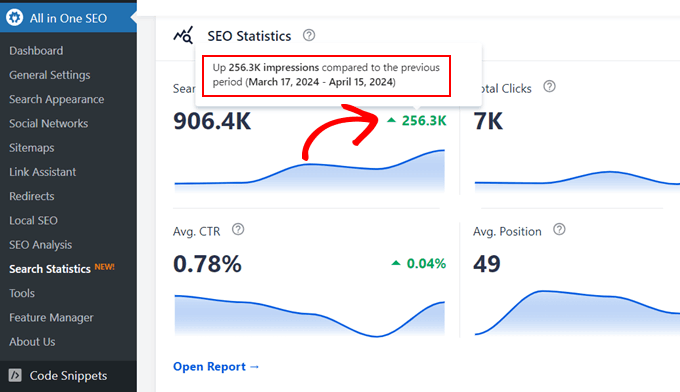
At WPBeginner, we really like All in One SEO’s Search Statistics feature because it is beginner-friendly and pulls data directly from Google Search Console.
You can learn how to use it in our guide on how to track website visitors to your WordPress site.
MonsterInsights is also a great option for seeing traffic reports on your website. It shows Google Analytics data in easy-to-understand reports with visual graphs for the number of sessions, pageviews, and more.
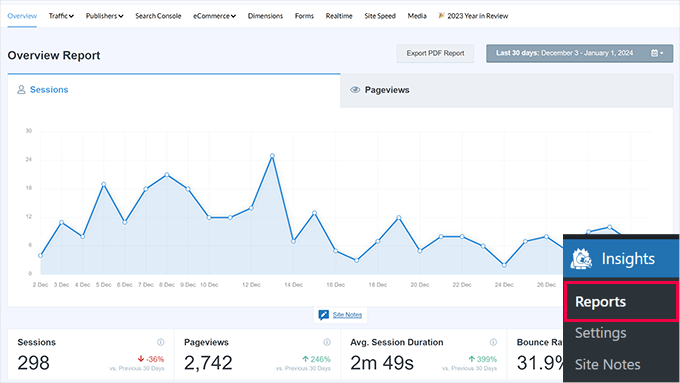
How Many Visitors Should You Expect During a High Traffic Event?
Now that you understand your website’s typical traffic patterns and have a baseline, it’s time to estimate how many visitors you might expect during a high-traffic event. This isn’t an exact science, but with careful analysis and planning, you can make a reasonable estimate.
Remember, it’s always better to overestimate than underestimate. This allows you to properly prepare your site for the surge in traffic.
You can use your website traffic analysis tool to identify previous traffic spikes, such as past marketing campaigns, holiday promotions, or unexpected mentions in the media.
Make sure to analyze the peak traffic you experienced during these events to understand your site’s potential capacity.
You should also identify the times of day and days of the week when you see the most traffic. This can help you anticipate when spikes may occur during a planned event.
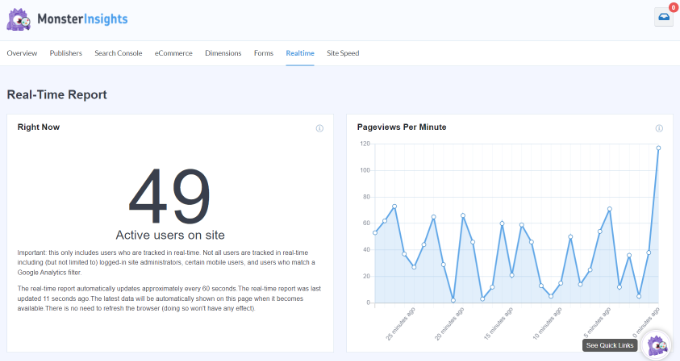
If possible, use your traffic tools to identify previous simultaneous users. This can help you determine how many users you can reasonably expect at a time.
Next, you can estimate the additional traffic you might generate from the email blast or marketing campaign you are planning.
To do this, you can multiply the number of people you are reaching by your typical click through rate (CTR). If other organizations are promoting your campaign, then you may get even more visitors.
Let’s look at a quick example. Let’s say you are sending an email about a new product to a list of 10,000 subscribers.
- If you have a 20% open rate and a 5% click-through rate, that’s roughly 1000 visitors potentially arriving at your site over a short period. You can assume that most of these users will arrive within 1-2 hours of the email.
- If you also promote the product on social media to an audience of 10,000 and have an engagement rate of 2%, that would be 200 visitors, again over a shorter period.
It is extremely difficult to predict the impact of an unexpected high-traffic event, such as a post on the front page of Reddit or a link from a major news outlet.
For unplanned events, assume a larger-than-average increase in traffic and then add a buffer. For example, If you are preparing for 200 simultaneous visitors but your site can handle 300, then you are in a much better position.
How Many Simultaneous Visitors Can Your Site Handle?
Once you understand your typical traffic volume and expected visitors during a high-traffic event, the next step is to determine how your site performs under pressure. This is where stress testing comes in.
A stress test simulates a high-traffic event, allowing you to measure your site’s breaking point—the number of users your site can handle simultaneously before performance degrades.
You can learn more by reading our guide on how to stress test a WordPress website.
For example, we performed a stress test on a demonstration site using the free plan of Loader.io. The graph below shows the results.
The green line represents the number of simulated visitors to the website, gradually increasing to 250 simultaneous users.
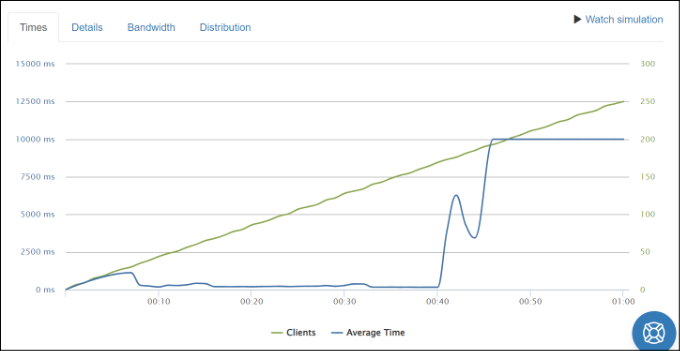
The blue line shows the website’s response time. Up to around 150 visitors, the response time is very quick. However, after that, the website’s performance degrades significantly, reaching its slowest response time when there are around 200 simultaneous users.
This indicates that the website is near its maximum capacity at around 150 users.
By understanding your site’s breaking point, you can make informed decisions about how to optimize it. We recommend using our tips below to improve your website’s performance.
Once you’ve improved your performance, you can run the stress test again to see how much additional traffic your site can now handle. Testing and optimization is an ongoing process.
Now that you have a better understanding of your website’s traffic capacity, let’s explore the steps you can take to prepare your WordPress site for a high-traffic event:
- Choose a Scalable Hosting Plan
- Install a WordPress Caching Plugin
- Use a Content Delivery Network (CDN)
- Optimize Your Images and Videos
- Get Expert Help
- Bonus: Protect Against Malicious Traffic Spikes
- Expert Guides for Handling High Traffic in WordPress
1. Choose a Scalable Hosting Plan
The amount of traffic a website can handle is often limited by its hosting plan. If you have low traffic, then you can choose the smallest, most cost-effective plan that meets your needs.
However, for high-traffic websites and preparing for a high-traffic event, it is essential to choose a hosting plan that can scale to your needs.
Choosing the right hosting plan is about planning for growth. If you plan on running marketing campaigns, you should ensure that your plan can scale to the increase in traffic.
You can find comprehensive speed and stress tests for many popular hosting providers in our comparison of the fastest WordPress hosting. We used the Load Impact (k6) service for our stress tests, as well as other tools for more comprehensive results.
To help you understand the potential of different hosting options, we’ve also explored how much traffic WordPress can handle with various hosting types.
Here are the key takeaways:
- Shared hosting plans are the most affordable and most common. They can typically handle over 100 simultaneous visitors and between 10,000 and 100,000 page views per month. However, they can struggle with sudden traffic spikes.
- Managed WordPress hosting is the next step up, where your hosting provider takes care of updates, security, and backups. These servers are tweaked to run faster and perform reliably under stress, and can handle upwards of 400,000 monthly visitors.
- Cloud hosting uses resources across multiple servers. If one server fails, then your website will remain available and can typically handle millions of pageviews per month. This is a good option for a website with highly variable traffic.
- Enterprise Custom Cloud Hosting like Amazon Web Services and Google Cloud offer highly scalable solutions capable of handling billions of monthly requests. This type of service is often overkill for most websites. However, it is great for sites that expect to grow to extremely large numbers of pageviews per month.
So, should you upgrade your hosting plan?
If your current hosting plan limits visitor numbers or resources, then you should seriously consider upgrading. This is especially important if it’s a shared hosting plan.
Upgrading to a better plan allows your site to use additional server resources to manage higher visitor volumes during traffic spikes. This will improve performance and handle more traffic.
Managed WordPress hosting is often the ideal choice for websites that are expecting to grow quickly, as these services can typically handle any amount of traffic required. You just need to pay for the additional hardware needed.
For example, we use and recommend SiteGround managed hosting because it uses the Google Cloud platform. This makes SiteGround’s servers very fast and highly reliable.

However, it is important to understand that upgrading to managed WordPress hosting costs more than shared hosting.
For more on this topic and for our top recommendations, see our guide on the best managed WordPress hosting compared.
At WPBeginner, we have learned firsthand the importance of choosing the right server size. Scaling too early can lead to unnecessary expenses while scaling too late can lead to downtime.
It is best to adjust your plan when your website starts to struggle or when you plan a large marketing campaign. By carefully balancing our server needs with our growth, we have ensured our websites remain fast and reliable.
To further understand your hosting needs, see our guide on how to determine the ideal size of a web server for your website.
2. Install a WordPress Caching Plugin
One of the most effective ways to prepare your WordPress website for a high-traffic event is to reduce the load that each visitor places on your server.
Instead of generating each page every time it is requested, which requires significant server resources, you can use caching to save static versions of your pages.
These static pages can be quickly displayed to new visitors instead of generating them again every time a user visits that page.
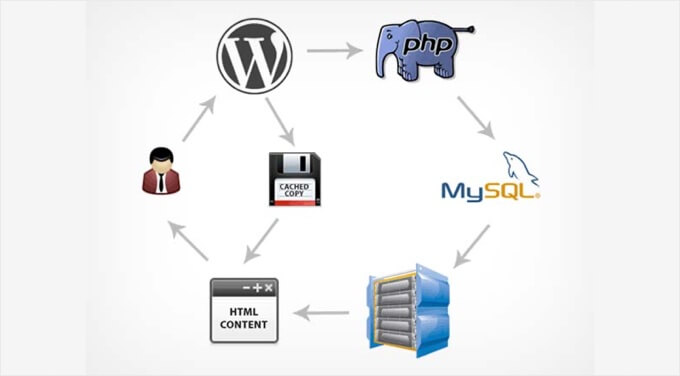
A caching plugin enables this process by serving these static versions of your site to users. As a result, your site loads much faster and can handle significantly more visitors at the same time. This is one of the most effective tools you can use to prepare for a high-traffic event.
Most WordPress hosting providers, like Bluehost, Hostinger, and SiteGround, include built-in caching solutions that are enabled by default. If you’re unsure, you can contact their support team to see if caching is active for your site and how it is configured.
While built-in caching can be helpful, a dedicated caching and performance plugin like WP Rocket offers more control and optimization options.
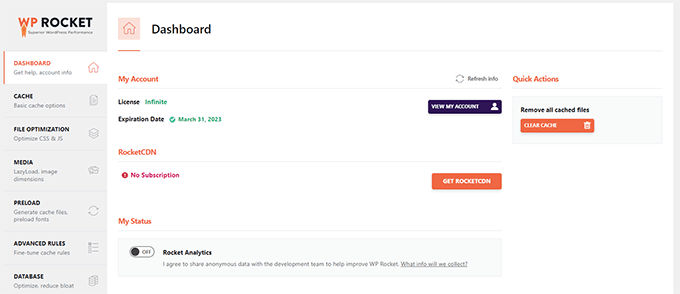
WP Rocket is beginner-friendly and automatically configures the best settings for most websites. It also allows for more customization for those with advanced needs. This plugin can significantly improve site speed and is an effective way to prepare for high traffic.
You can learn more in our detailed WP Rocket review.
3. Use a Content Delivery Network (CDN)
Another powerful way to prepare your website for high-traffic events is to use a Content Delivery Network (CDN). A CDN is a network of servers around the world that work together to deliver static content to your users.
Distributing content to multiple servers, such as images, JavaScript, and CSS files, can greatly reduce the load on your main WordPress server.
Instead of relying on your web server alone, a CDN caches your static content on servers closer to your users. When a visitor goes to your website, the CDN delivers the content from the server nearest to their location, resulting in faster loading times.
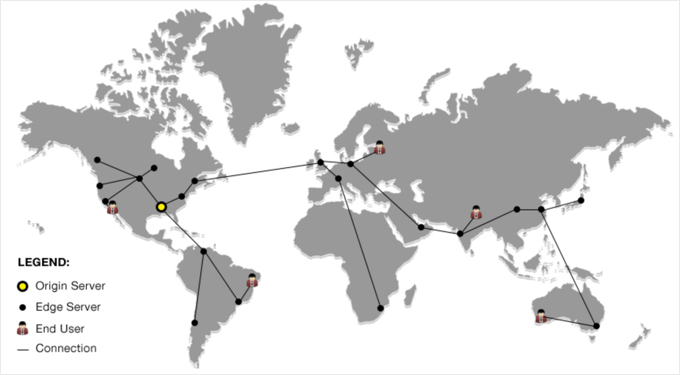
This distribution of resources can dramatically improve a site’s ability to handle traffic surges.
Plus, a CDN not only reduces the load on your server but also dramatically improves the response time for your users by serving files from locations closer to them. This is especially beneficial during high-traffic events, as it will ensure your site remains fast and reliable.
At WPBeginner, we’ve experienced the benefits of a CDN firsthand. We use Cloudflare and previously used WP Rocket’s CDN on WPBeginner.
This has allowed us to improve our user experience, reduce the load on our servers, and ensure fast content delivery to our global audience. It has also resulted in a smoother browsing experience and more satisfied visitors.
We also highly recommend Bunny.net as another excellent CDN option. It is known for being easy to integrate with WordPress, even for absolute beginners, and offers a wide range of advanced features and good performance.

4. Optimize Your Images and Videos
Poorly optimized images and videos are a major reason why websites slow down and can’t handle many visitors at once. If you want your website to be ready for a big event, then you need to make sure your media files are optimized.
To begin, focus on image optimization. Large image files can slow down your site. You can compress large image files to reduce their file size without a significant loss in visual quality.
At WPBeginner, all of our authors follow a rigorous process when uploading images, including proper sizing and compression of all files. They size each image with the right dimensions and then reduce image file size using a variety of graphics tools and techniques.
This process ensures that every image is ready for use on the web and doesn’t cause performance issues.

Using these optimization techniques can often reduce image file sizes by 70% or more, with little visible loss in quality.
Smaller files result in faster download times, reduced server load, and better user experience. This is a critical factor when dealing with a high-traffic event.
For more detailed guidance on optimizing your images for the web, see our step-by-step guide on how to optimize images for web performance without losing quality.
Additionally, if you’re hosting videos directly on your site, then consider using third-party platforms like YouTube or Vimeo and then embedding them in your content.

This approach drastically reduces the load on your server by utilizing the robust video infrastructure of these dedicated platforms. This ensures smooth playback without impacting your website performance.
Once you optimize your media files, the load on your server will be dramatically reduced, and your site will perform more smoothly during high-traffic events.
5. Get Expert Help
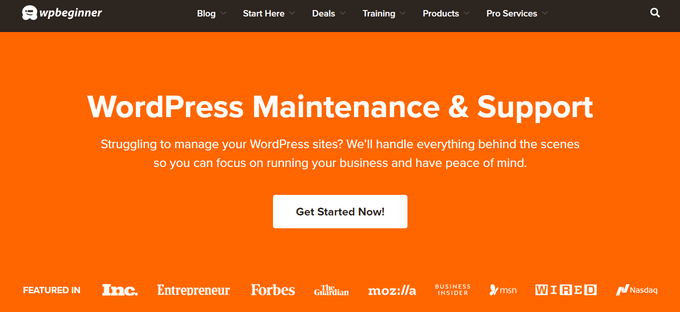
As you have seen, preparing your website for a high-traffic event involves a few technical steps.
The last thing you want is for a successful marketing campaign to be undermined by a website that can’t handle enough visitors. Imagine the frustration of customers facing slow loading times.
That’s why many website owners look for professional help. Whether you’re short on time, prefer to focus on other aspects of your business, or simply feel overwhelmed by the technical details, our WordPress maintenance service can provide you with peace of mind.
Our team of WordPress experts can optimize your website performance. We focus on preventing slow loading times and downtime, ensuring your site runs smoothly even under high-traffic conditions. This allows you to focus on what matters most: growing your business.
Our maintenance plans start at just $49 per month, offering a flexible and cost-effective solution. Explore our maintenance plans now and discover how we can help you get a worry-free website.
Bonus: Protect Against Malicious Traffic Spikes
High-traffic events are typically a positive sign, indicating increased interest in your products or services. But it’s important to recognize that not all traffic spikes are welcome.
A Distributed Denial of Service (DDoS) attack is a malicious type of high-traffic event where hackers flood your website with fake requests. Their plan is to overwhelm your server and crash your site. Essentially, these attacks involve an army of bots, sending a massive volume of traffic to your website.
This can lead to significant financial losses, a damaged reputation, and frustrated customers. That’s why it’s important to be proactive about protecting your website from these harmful attacks.
Because these malicious requests are unwelcome and harmful to your site, you will want to block them before they reach your website. The most effective way to filter suspicious traffic is by using a website application firewall.
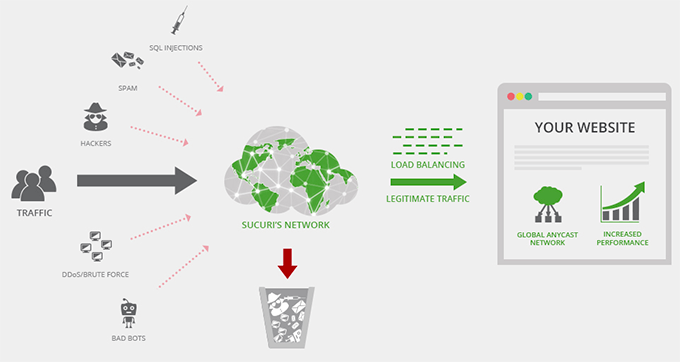
At WPBeginner, we have experienced the benefits of using a website firewall. We previously used Sucuri and were able to block 450,000 WordPress attacks in just three months. We have since switched to Cloudflare, but both are excellent solutions for website security.
So, don’t forget DDoS attacks while preparing your website for high-traffic events. They can be extremely harmful to your business, and a firewall is an important step in protecting your website.
For detailed instructions, see our guide on how to stop and prevent a DDoS attack on WordPress.
Expert Guides for Handling High Traffic in WordPress
We hope this tutorial helped you learn how to prepare your WordPress site for a high-traffic event.
You may also want to see some other guides related to WordPress traffic:
- How Much Traffic Can WordPress Handle? (+ Expert Scaling Tips)
- How to Check Website Traffic for Any Site
- How to Stress Test a WordPress Website (Step by Step)
- How to Track Website Visitors to Your WordPress Site
- How to Determine the Ideal Size of a Web Server for Your Website
- When Do You Really Need Managed WordPress Hosting? Best Managed WordPress Hosting Compared
If you liked this article, then please subscribe to our YouTube Channel for WordPress video tutorials. You can also find us on Twitter and Facebook.
The post How to Prepare Your WordPress Site for a High Traffic Event first appeared on WPBeginner.
این خبر را در ایران وب سازان مرجع وب و فناوری دنبال کنید
مشاهده پاسخ های این مطلب
———————————————
این مطلب از سایت انجمن وردپرس گردآوری شده است و کلیه حقوق مطلق به انجمن وردپرس می باشد در صورت مغایرت و یا بروز مشکل اطلاع دهید تا حذف گردد
منبع: انجمن وردپرس
این خبر توسط موتور ارتباط اقتصادی جمع آوری شده است در صورت مغایرت اطلاع دهید



